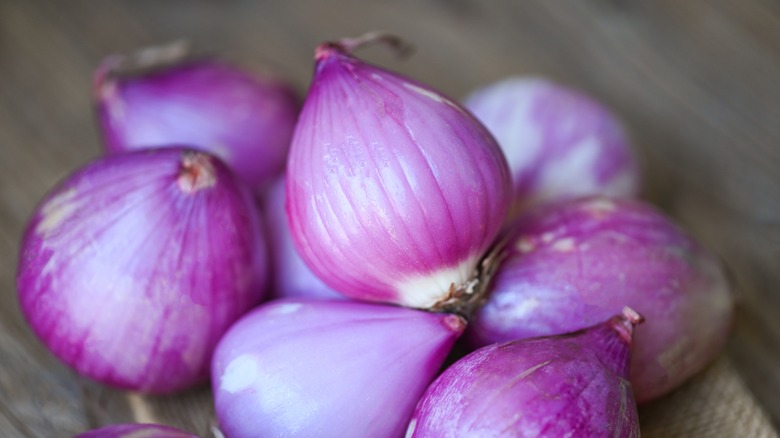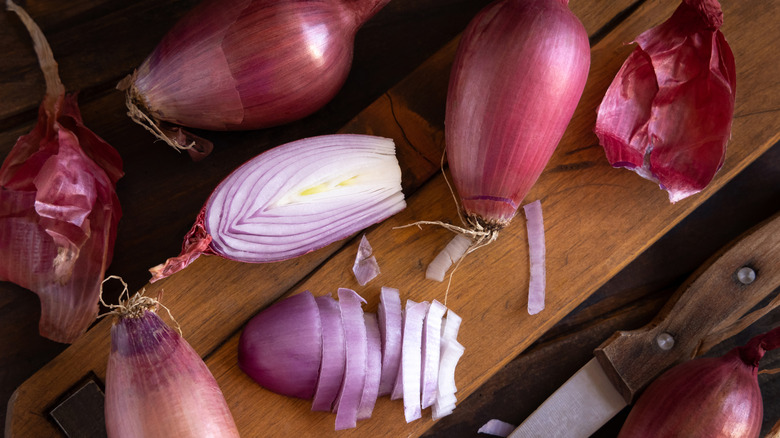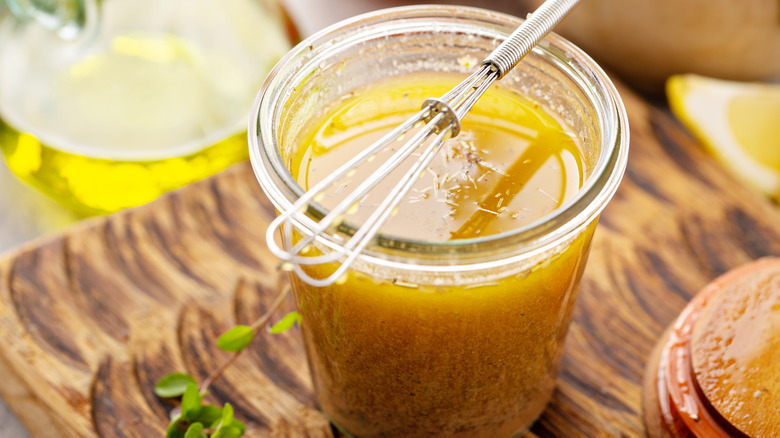Shallots Are The Key To A Better Salad Dressing
Salads can be an afterthought or dismissed as "health food." But a well-made salad with crisp vegetables and the right dressing is a little bit ethereal. The problem with salads is that a lot of them are made with less-than-ideal vegetables, and they get topped with salad dressings that are too sweet, have gloppy textures, and dominate the taste of everything in the bowl. The dressing really matters — and one of the easiest ways to elevate your homemade dressing is to start using shallots.
These alliums are a type of onion that are a staple in commercial kitchens for their small-but-mighty flavor profile, and they make all the difference when you're mixing up a homemade salad dressing.
Although shallots are similar to red onions, they bring a little something different to the table when it comes to flavor and texture. They're slightly pricier than onions, but you only need one or two to make a bowl of greens come alive. Once you try using shallots in a salad dressing, there'll be no more wasted bags of spring mix in your refrigerator because you'll be craving salad all the time.
Shallot basics
If you've never cooked with shallots before, you can find them in your grocery store produce section near the onions and garlic. They are in the same family as the other alliums, and are usually between the size of a small onion and a head of garlic. They're super aromatic, and they show up quite a lot in Mediterranean, French, and Southeast Asian recipes. They have a more intense flavor than an onion without the harshness, so they're the ideal base for building flavor in dressings and sauces.
When it comes to salad dressing, shallots are kings because you can either thinly slice them and toss them in a dressing for flavor and rustic crunch, or you can finely mince them for a dressing that packs a punch in every bite. They're equally at home in a vinaigrette or in a creamy dressing, and you can use them raw or cooked. Shallots can star in salad dressing recipes, or they can be a key player in a medley of ingredients.
If you want to experiment with using shallots in homemade salad dressing, start with adding them to a basic vinaigrette recipe to get an idea of how they taste. For an easy, five-minute dressing anytime, you can stick to this or any basic vinaigrette recipe and just add diced shallots for an extra kick.
Sliced or diced?
Once you know how shallots will taste in a vinaigrette, you can branch out and try different techniques for adding them to all kinds of dressing recipes. In fact, almost every restaurant vinaigrette is built with some combination of shallots and Dijon mustard.
Much like red onions, shallots are also tasty when they're quick-pickled in vinegar, so try soaking thin slices with the liquid you're going to use for a dressing. Let the slices marinate in the vinegar for 15 minutes or so and then add the other ingredients. Whisk or shake everything up and add it to your salad.
Shallots are also delicious when they're cooked because their sugars create rich caramelization. You can sauté them before you add them to a salad dressing (which can be served cold or warm), or roast them whole like garlic confit, purée them, and then whisk some of the paste into your dressing for a subtle, earthy onion-ness. There's almost no wrong way to include shallots in your dressing. Just make sure to always balance your recipe with acid (vinegar) and fat (oil or creamy ingredients like mayonnaise or yogurt), and your salad dressing will come out balanced — and tasty — every time.


